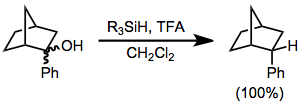Scope
Deoxygenation of alcohols and halides
Some alcohols are reduced to alkanes when treated with hydrosilanes in the presence of a strong Lewis acid. Brønsted acids may also be used. Tertiary alcohols undergo facile reduction using boron trifluoride etherate as the Lewis acid. [2] Primary alcohols require an excess of the silane, a stronger Lewis acid, and long reaction times. [3]
Skeletal rearrangements are sometimes induced. [4] Another side reaction is nucleophilic attack of the conjugate base on the intermediate carbocation. [5] In organosilane reductions of substrates bearing prostereogenic groups, diastereoselectivity is often high. Reduction of either diastereomer of 2-phenyl-2-norbornanol leads exclusively to the endo diastereomer of 2-phenylnorbornane. [6] None of the exo diastereomer was observed.
Allylic alcohols may be deoxygenated in the presence of tertiary alcohols when ethereal lithium perchlorate is employed as a source of Li+. [7]
Reductions of alkyl halides and triflates gives poorer yields in general than reductions of alcohols. A Lewis or Bronsted acid is required. [8]
Reduction of carbonyls
- Aldehydes and ketones
Polymeric hydrosilanes, such as polymethylhydrosiloxane (PHMS), may be employed to facilitate separation of the reduced products from silicon-containing byproducts. [9] [10]
Enantioselective reductions of ketones may be accomplished through the use of catalytic amounts of chiral transition metal complexes. [11] In some cases, the transition metal simply serves as a Lewis acid that coordinates to the ketone oxygen; however, some metals (most notably copper) react with hydrosilanes to afford metal hydride intermediates, which act as the active reducing agent. [12]
In the presence of rhodium catalyst 1 and rhodium trichloride, 2-phenylcyclohexanone is reduced with no diastereoselectivity but high enantioselectivity. [13]
- Esters
Esters may be reduced to alcohols under conditions of nucleophilic activation with caesium or potassium fluoride. [14]
Aldehydes undergo hydrosilylation in the presence of hydrosilanes and fluoride. The resulting silyl ethers can be hydrolyzed with 1 M hydrochloric acid. Optimal yields of the hydrosilylation are obtained when the reaction is carried out in very polar solvents. [10]
| 13 |
Reduction of C=C bonds
Hydrosilanes can reduce 1,1-disubstituted double bonds that form stable tertiary carbocations upon protonation. Trisubstituted double bonds may be reduced selectively in the presence of 1,2-disubstituted or monosubstituted alkenes. [15]
Aromatic compounds may be reduced with TFA and triethylsilane. Substituted furans are reduced to tetrahydrofuran derivatives in high yield. [16]
A synthesis of (+)-estrone relies on selective hydrosilane reduction of a conjugated alkene as a key step. The ketone carbonyl and isolated double bond are unaffected under the conditions shown. [17]
Ether cleavage
Acetals, ketals, and aminals are reduced in the presence of hydrosilanes and acid. Site-selective reduction of acetals and ketals whose oxygens are inequivalent have been reported—the example below is used in a synthesis of Tamiflu. [18]
Other functional groups that have been reduced with hydrosilanes include amides, [19] and α,β-unsaturated esters [20] enamines, [21] imines, [22] and azides. [23]













